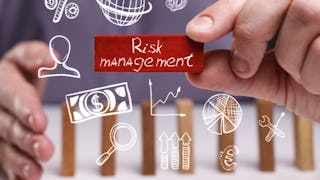What is risk? Why do firms manage risk? In this course, you will be introduced to the different types of business and financial risks, their sources, and best practice methods for measuring risk. This course will help you gauge different risk types and set risk limits, describe the key factors that drive each type of risk, and identify the steps needed to choose probability distributions to estimate risk. You will explore the history and development of risk management as a science, and financial and business trends that have shaped the practice of risk management. By the end of the course, you will have the essential knowledge to measure, assess, and manage risk in your organization.



Introduction to Risk Management
This course is part of Risk Management Specialization


Instructors: Joseph Iraci
Access provided by Coursera Learning Team
43,071 already enrolled
(689 reviews)
Recommended experience
What you'll learn
Differentiate between financial and business risks
Examine the key concepts and factors of risk measurement
Understand the application of risk modeling
Understand the principles of risk management
Skills you'll gain
Details to know

Add to your LinkedIn profile
4 assignments
See how employees at top companies are mastering in-demand skills

Build your subject-matter expertise
- Learn new concepts from industry experts
- Gain a foundational understanding of a subject or tool
- Develop job-relevant skills with hands-on projects
- Earn a shareable career certificate


Earn a career certificate
Add this credential to your LinkedIn profile, resume, or CV
Share it on social media and in your performance review

There are 6 modules in this course
This course will introduce you to different types of business and financial risk. You will learn how these risks are measured and also gain an understanding of the goals and benefits of risk management. The skills that you will gain by the end of this course will enable you to measure and manage risk in your organization.
What's included
1 video4 readings1 discussion prompt1 plugin
In this module, you will learn about financial and business risks. You will also get introduced to the various types of financial risks and learn about their sources and how firms manage risks. We'll also look at the difference between risk measurement and risk management. Let's get started.
What's included
2 videos2 readings1 assignment3 discussion prompts
In this module, you will learn about the four main types of financial risk. You will then learn about the best measures to use to gauge different risk types and set risk limits. You will also learn how investment managers maximize portfolio returns while keeping risk within their tolerances and then apply these techniques to a portfolio you will construct.
What's included
10 videos1 reading1 assignment6 discussion prompts
In this module, you will learn the difference between Money and Capital markets. You will also learn to differentiate among the 3 regulatory structures - US, UK, and EU and understand how regulatory structures impact your firm.
What's included
5 videos2 readings1 assignment3 discussion prompts
In this module, you will learn about the factors that drive each type of risk and then use these factors to create distributions (density functions). You will explore non-parametric measures of loss distributions such as scenario analysis and stress testing.
What's included
5 videos2 readings1 assignment2 discussion prompts
You've come to the end of the course. Let's wrap up with a quick summary of the key takeaways of this course.
What's included
1 video1 reading1 discussion prompt1 plugin
Instructors


Offered by
Why people choose Coursera for their career




Learner reviews
689 reviews
- 5 stars
73.62%
- 4 stars
20.43%
- 3 stars
3.62%
- 2 stars
0.86%
- 1 star
1.44%
Showing 3 of 689
Reviewed on Jun 5, 2023
It was amazing, however, when it comes to equations and formulas, I would like to have a more clear explanation, perhaps a en example on practical usage. Thank you
Reviewed on Jun 25, 2024
It is a great course as a beginner to learn about risk management
Reviewed on Mar 29, 2022
Introduction to Risk Management is very useful subjet for our feature,it helps in our business,companies,industries and also lifes
Explore more from Business

New York Institute of Finance

University of California, Irvine

Corporate Finance Institute

New York Institute of Finance

Open new doors with Coursera Plus
Unlimited access to 10,000+ world-class courses, hands-on projects, and job-ready certificate programs - all included in your subscription
Advance your career with an online degree
Earn a degree from world-class universities - 100% online
Join over 3,400 global companies that choose Coursera for Business
Upskill your employees to excel in the digital economy

